Cleaning solutions for orthodontic clear aligners: a microbiological and colorimetric analysis
Artigo Original
Objective: This in-vitro study aimed to evaluate the antibacterial efficacy and color changes induced by different chemical agents on the orthodontic aligners. Methods: The sample consisted of Invisalign® aligners materials and seven solutions were tested: sodium hypochlorite (HYP), sodium bicarbonate (BIC), neutral detergent (DET), chlorhexidine gluconate (CX), white vinegar (VIN) diluted in water (1:3), Corega Tabs® effervescent tablets (COR), and distilled water (DW, control group). The microbiological control was evaluated by analyzing cell proliferation (CFU/ml) and cell metabolism...
Autores: Ary Dos Santos-Pinto, Luiz Gonzaga Gandini Jr, João Roberto Gonçalves, Paula Cristina Henriques da Silva, Jonas Bianchi, Beatriz Ribeiro RIBAS, Tony Vieira FARIA, Janaína Habib JORGE,
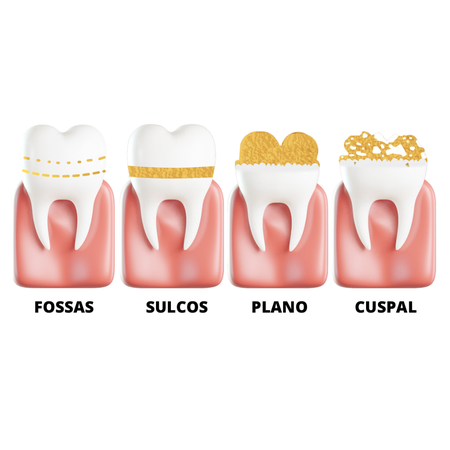
Introdução: Os defeitos de desenvolvimento do esmalte (DDE) representam um desafio significativo para os cirurgiões-dentistas, particularmente para os ortodontistas. Desafios como a dificuldade no diagnóstico diferencial, na adesão do aparelho ortodôntico, no planejamento do tratamento e na gestão global do paciente. Objetivo: A presente revisão da literatura tem como objetivo fornecer aos ortodontistas uma compreensão abrangente dos DDE e suas implicações para o tratamento...
Leia mais
Objetivo: Investigar os fatores que influenciam a prescrição de exames de tomografia computadorizada de feixe cônico (TCFC) na prática ortodôntica brasileira. Métodos: Este estudo transversal foi realizado em 2020, por meio de uma pesquisa online enviada a todos os ortodontistas brasileiros registrados no Conselho Federal de Odontologia. As variáveis foram as características demográficas dos ortodontistas e a prescrição de TCFC na prática clínica. Análises descritiva e...
Leia mais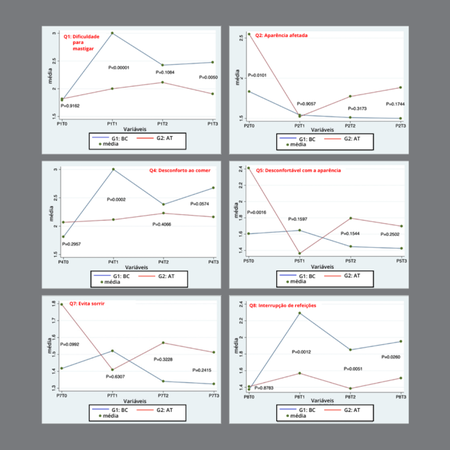
Objetivo: Comparar o impacto na Qualidade de Vida Relacionada à Saúde Bucal (QVRSB) e a percepção da dor entre pacientes adultos submetidos ao tratamento convencional com aparelhos fixos (BC) e aqueles submetidos ao tratamento com alinhadores transparentes (AT) durante os três primeiros meses do tratamento ortodôntico (TOrtod). Métodos: A QVRSB foi medida pelo Oral Health Impact Profile (OHIP-S14 Ortho) e a percepção da dor foi avaliada pela escala visual analógica (EVA). Os...
Leia mais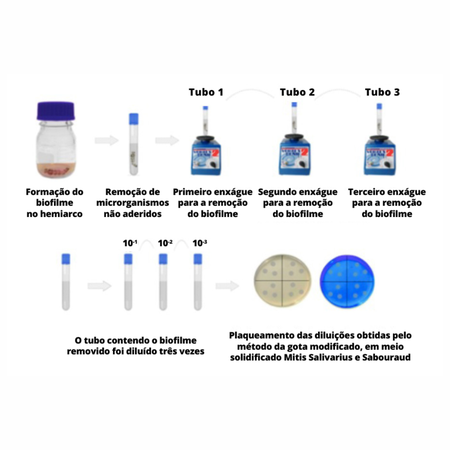
Introdução: Os alinhadores têm sido utilizados pela comunidade ortodôntica há aproximadamente 20 anos, mas poucos estudos têm sido realizados sobre a formação de biofilme na superfície desses alinhadores, bem como o seu possível impacto no ecossistema oral. Métodos: Foram utilizados dez hemiarcos de alinhadores ortodônticos da marca Invisalign®. Os hemiarcos foram colocados dentro de frascos estéreis contendo 25mL de caldo Gibbons e Nygaard, com suspensões padronizadas em 0,5...
Leia mais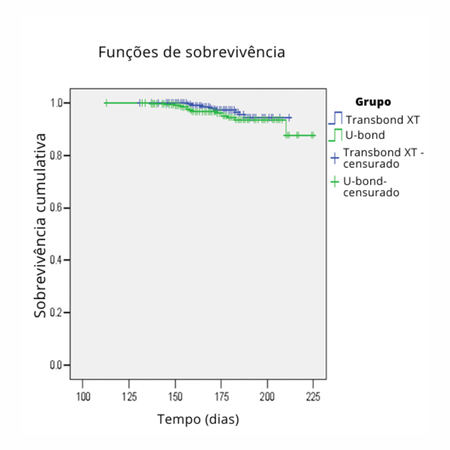
Introdução: Melhorias contínuas no campo da adesão em Odontologia levaram à introdução de novos materiais que têm o potencial de ser usados como adesivos ortodônticos. Um desses adesivos ortodônticos fotopolimerizáveis é o U-Bond™ Ortho, que clinicamente apresenta uma ótima força de adesão. Objetivo: O objetivo desse estudo prospectivo de boca dividida foi avaliar a taxa de falhas de colagem e o tempo de sobrevivência de braquetes colados com U-Bond™ Ortho, em...
Leia mais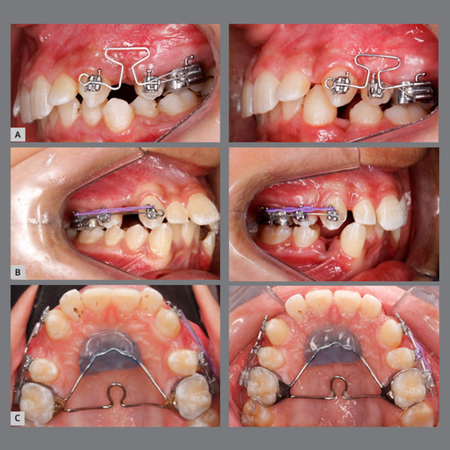
Objetivo: O objetivo deste estudo foi avaliar e comparar a eficácia de elásticos Power Chain e molas T-loop na retração do canino superior em um período de quatro meses. Material e Métodos: O estudo incluiu 16 pacientes (8 mulheres e 8 homens), com idade média de 19,06±2,22 anos. Os pacientes foram planejados para extração bilateral dos primeiros pré-molares superiores. Um design de boca dividida foi usado nesse estudo, para atribuir aleatoriamente quadrantes opostos aos Power...
Leia mais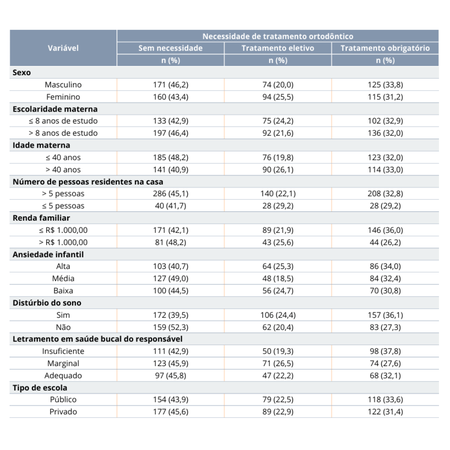
Introdução: A má oclusão é um problema de saúde global e, quando não tratada na infância, pode persistir por toda a vida. Objetivo: Como as crianças são dependentes dos pais/responsáveis para cuidados de saúde, o objetivo do presente estudo foi investigar a associação entre o letramento parental em saúde bucal e a necessidade de tratamento ortodôntico em escolares. Material e Métodos: Estudo transversal, descritivo e analítico, com amostra representativa de crianças com 8...
Leia mais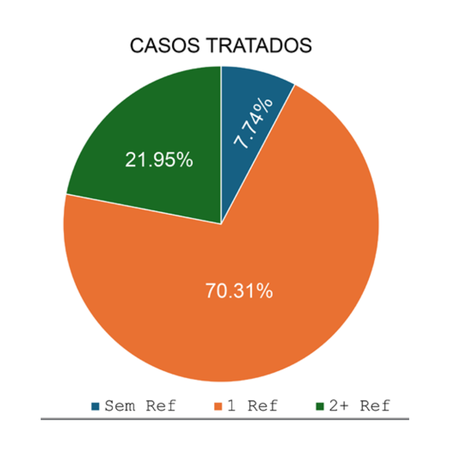
Objetivo: Avaliar com que frequência os ortodontistas solicitam alinhadores adicionais e correlacionar essa necessidade com a experiência profissional. Método: Um questionário foi enviado por um aplicativo de mensagens instantâneas para 188 ortodontistas que o responderam voluntariamente. Os respondentes foram agrupados de acordo com sua experiência, incluindo o Tempo de Formação em Ortodontia, Tempo de Trabalho com Alinhadores e Número de Casos Tratados com alinhadores. Também foram...
Leia mais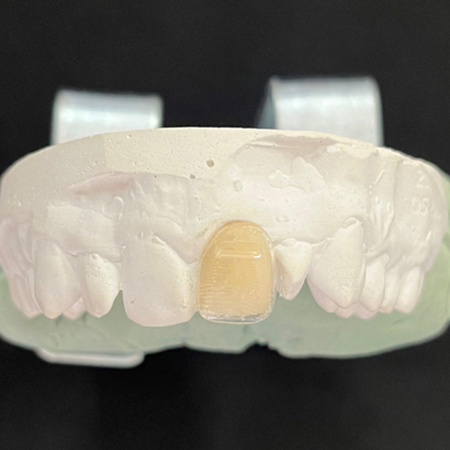
Objetivo: Este estudo in vitro teve como objetivo avaliar a eficácia antibacteriana e as alterações de cor induzidas por diferentes agentes químicos nos alinhadores ortodônticos. Métodos: A amostra foi composta por alinhadores Invisalign®, e foram testadas sete soluções: hipoclorito de sódio (HIP), bicarbonato de sódio (BIC), detergente neutro (DET), gluconato de clorexidina (CX), vinagre branco (VIN) diluído em água (1:3), comprimidos efervescentes Corega tabs® (COR) e água...
Leia mais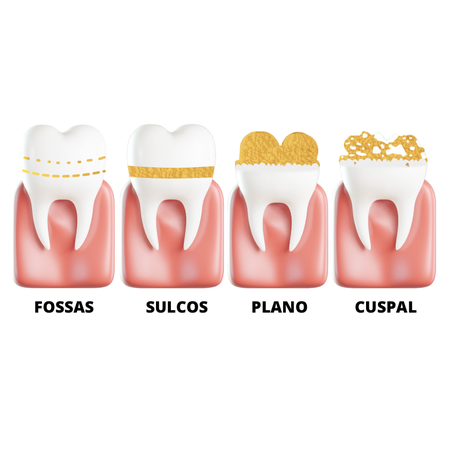
Introduction: Developmental Enamel Defects (DED) pose a significant challenge for clinicians, particularly orthodontists. These defects can lead to difficulties in differential diagnosis, orthodontic appliance adhesion, treatment planning, and overall patient management. Objective: The present review aims to provide orthodontists with a comprehensive understanding of DED and their implications for orthodontic treatment. A systematic literature search was conducted to identify relevant...
Leia mais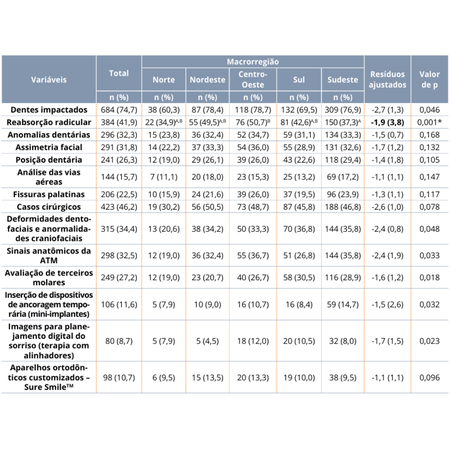
Objective: To investigate the factors that influence Cone-beam computed tomography (CBCT) imaging prescription in Brazilian orthodontics practice. Methods: This cross-sectional study was performed in 2020 using an online survey sent to all Brazilian orthodontists registered at the Federal Council of Dentistry. The variables were the orthodontists’ demographic features and the CBCT prescription in clinical practice. A descriptive and comparative analysis was implemented using frequencies...
Leia mais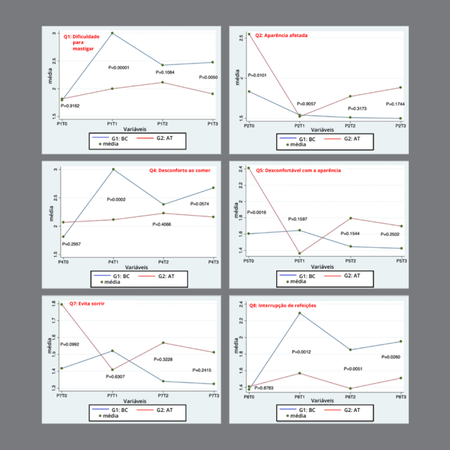
Objective: To compare the impact on Oral Health Related Quality of Life (OHRQoL) and pain perception between adult patients undergoing fixed conventional bracket treatment (FCBT) and those undergoing clear aligner treatment (CAT) during the first three months of orthodontic treatment (OT). Method: OHRQoL was measured by the Oral Health Impact Profile (OHIP-S14 Ortho), pain perception was evaluated by the visual analog scale (VAS). The on-line questionnaires were administered immediately before...
Leia mais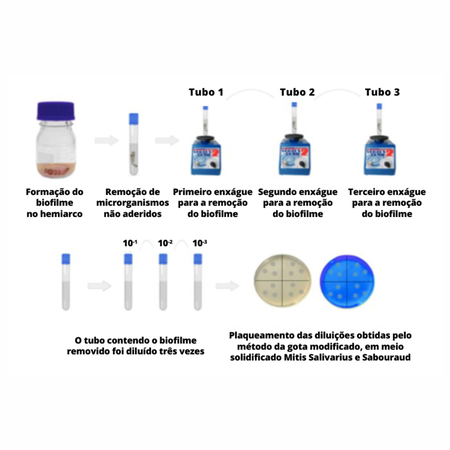
Introduction: Aligners have been used by the orthodontic community for approximately 20 years, but little research has been carried out on the accumulation of biofilm on the surface of these aligners, as well as their possible impact on the oral ecosystem. Methods: Ten hemi-arches of Invisalign® brand orthodontic aligners were used. The hemi-arches were placed inside sterile flasks containing 25 mL of Gibbons and Nygaard broth, with standardized suspensions of the two microorganisms on the 0.5...
Leia mais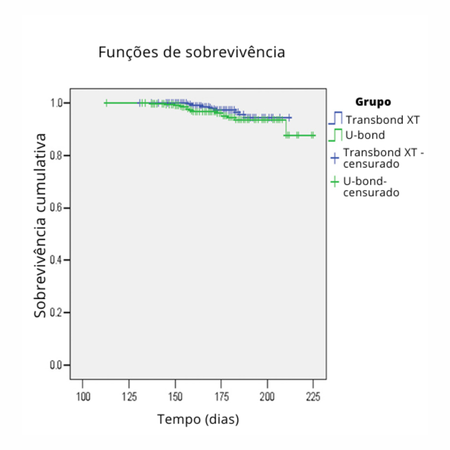
Introduction: Continuous improvements in the field of adhesive dentistry have led to the introduction of various materials that have the potential to be used as orthodontic adhesives. One such light-cure orthodontic adhesive is the U-Bond™ Ortho, which clinically exhibits optimum bonding strength. Objective: The aim of this cross-arch split-mouth prospective study was to evaluate the bonding failure rate along with the bracket survival time of U-Bond™ Ortho as compared with Transbond™...
Leia mais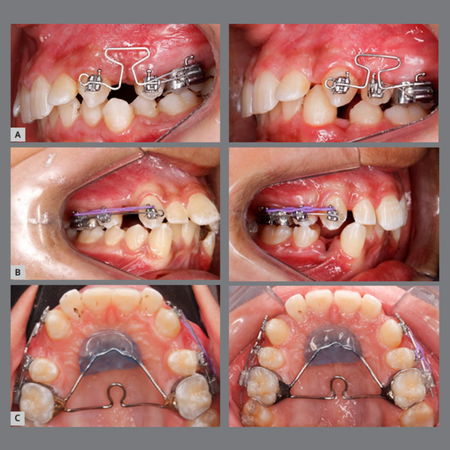
Objective: The aim of this study was to evaluate and compare the effectiveness of elastomeric power chains and T-loop springs in retracting the maxillary canine with a time frame of four months. Material and Methods: The study included 16 patients (8 women and 8 men), with a mean age of 19.06±2.22 years. These patients were recommended to bilateral maxillary first premolars extraction. A split-mouth design was used to randomly assign opposing quadrants to either power chains or T-loops....
Leia mais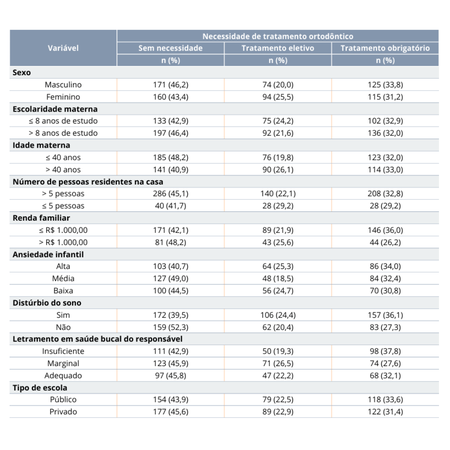
Introduction: Malocclusion is a global health problem and when not treated in childhood, can persist throughout one’s lifetime. Objective: As children are dependent on their parents/caregivers for health care, the aim of the present study was to investigate the association between parental oral health literacy and orthodontic treatment need in schoolchildren. Methods: A descriptive, analytical, cross-sectional study with a representative sample of children eight to ten years of age was...
Leia mais
Objective: To assess how often orthodontists request additional aligners and correlate this need with professional’s experience. Methods: A questionnaire was sent by instant messaging app (WhatsApp) to 188 orthodontists who answered it voluntarily. Respondents were grouped by experience, including time of orthodontic training (OT), training with aligners (TA) and number of cases treated with aligners (TC). They were also surveyed about the cases in which they recommend aligners. Chi-square...
Leia mais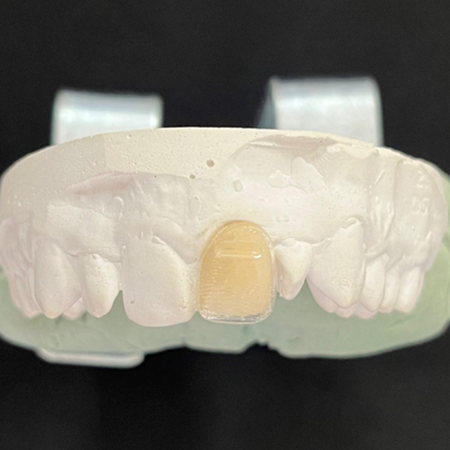
Objective: This in-vitro study aimed to evaluate the antibacterial efficacy and color changes induced by different chemical agents on the orthodontic aligners. Methods: The sample consisted of Invisalign® aligners materials and seven solutions were tested: sodium hypochlorite (HYP), sodium bicarbonate (BIC), neutral detergent (DET), chlorhexidine gluconate (CX), white vinegar (VIN) diluted in water (1:3), Corega Tabs® effervescent tablets (COR), and distilled water (DW, control group). The...
Leia maisCopyright © 1996 - 2024 DentalGO | Todos Direitos Reservados. DentalGO é uma marca Dental Press
Login